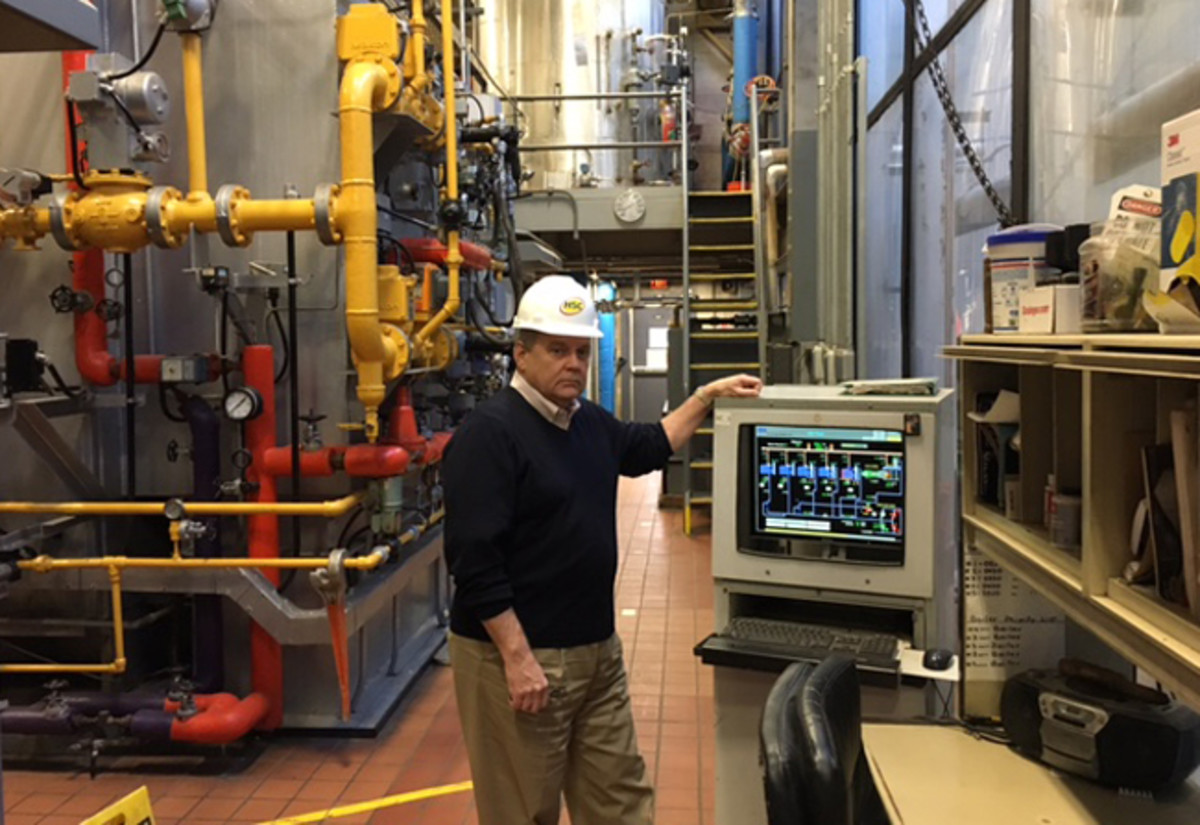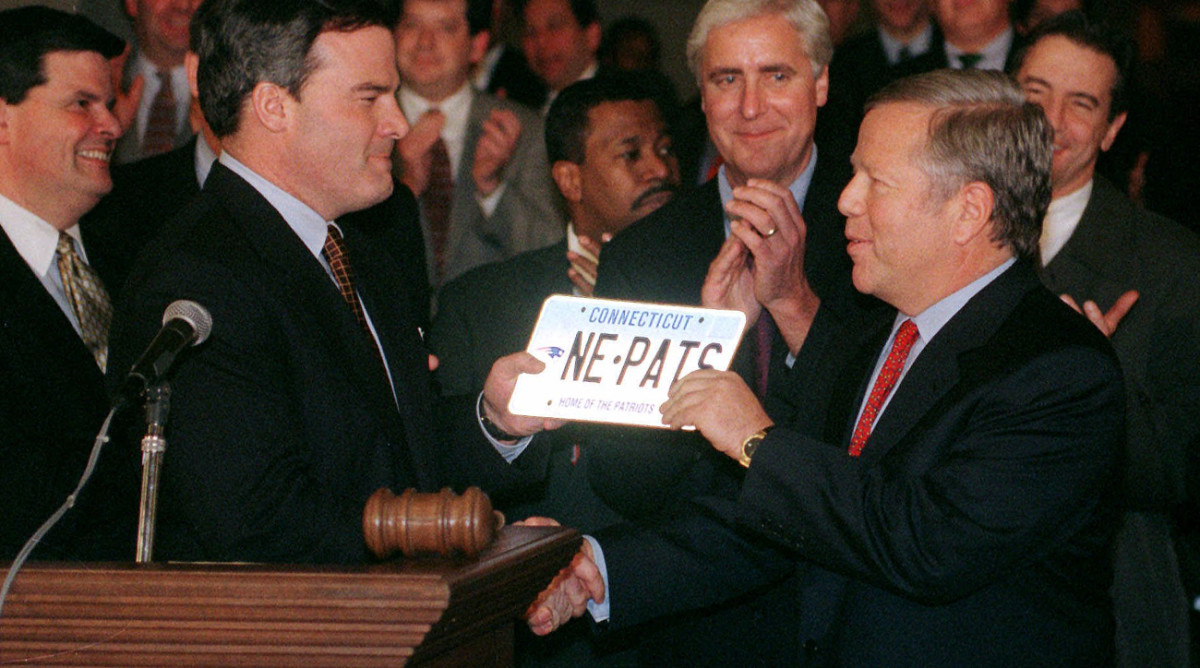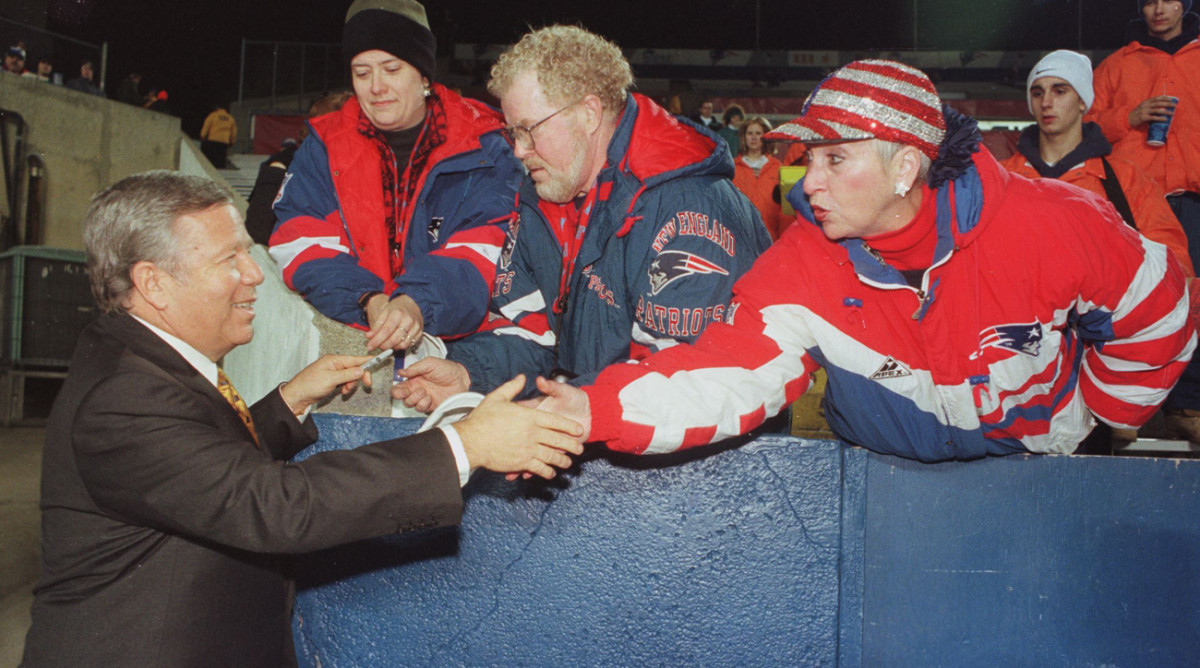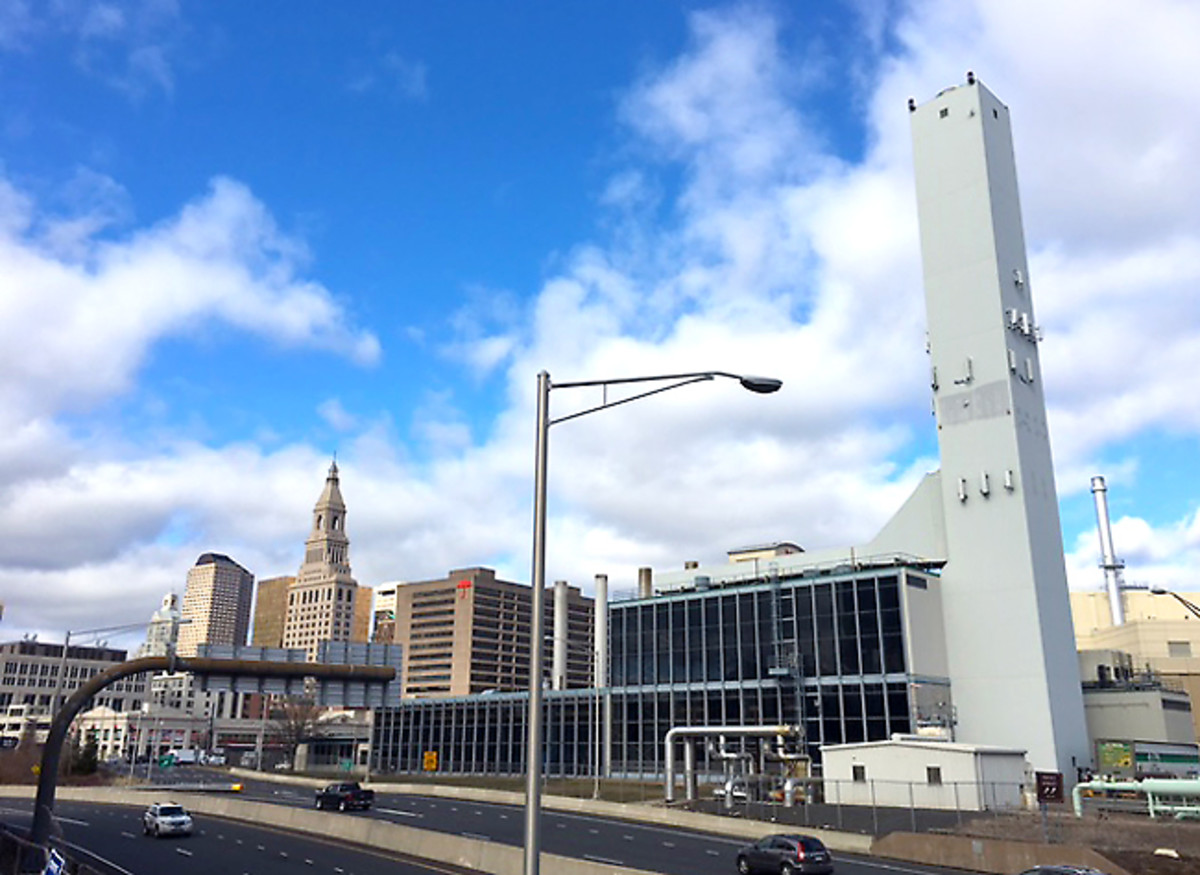Hartford’s White Whale: How the Patriots Almost Became Connecticut’s Team

The MMQB is back on the road for the Super Bowl. Jenny Vrentas, Tim Rohan, Kalyn Kahler and our video team are driving to Houston for Super Bowl 51, along the way doing stories, videos and social content on the Patriots and Falcons and the biggest sporting event in America. Follow our #RoadtoHouston on Twitter and Facebook.
HARTFORD, Conn. — Sometime around the end of 1998, a group of local politicians gathered at the Hartford Steam Plant for a tour. Jeff Lindberg, the plant’s director of marketing and sales, gave them hard hats and safety goggles and led them to the main floor. He pointed out the row of chillers, the blue, torpedo-shaped tanks that looked to be about 10-yards long. Then he showed them the boilers, the box-shaped contraptions that looked like room-sized car engines. As the politicians walked through, they kept craning their necks and looking around in awe, as if they were in a museum.
They were there because the Connecticut governor was making plans to build the New England Patriots a new stadium on the site of the plant. The state was prepared to spend upwards of $1 billion on the stadium, infrastructure upgrades, and guaranteed revenue to persuade the Patriots to move from Massachusetts, where they’d played since their inception 38 years earlier, to Hartford, the state capital and a city of about 125,000 people.
Robert Kraft, the Patriots’ owner, eventually signed the deal with Hartford—and it was considered perhaps the best deal a state had ever given a sports team. There was a press conference and a rally and Connecticut officials dreamed up big, elaborate plans. And then, three months later, the dream died. The Patriots worked out a new stadium deal in Massachusetts, in large part because of issues with the steam plant.
After the group saw the main floor, Lindberg led them downstairs to the lower level. Lower level? The politicians looked at each other. There was more? They had to duck under pipes and watch their step, maneuvering around all the equipment. All the compressors, feed-water pumps, and service lines. The fuel lines, electrical switchgears, and Freon holding tanks. The miles of control lines and the distribution piping that snaked around the ceiling and looped here, there, everywhere. The piping looked like oversized spaghetti noodles, all tangled together.
Flowing in those distribution pipes was either chilled water or steam. The plant had been built on this site, in 1962, so it could draw water from the nearby Connecticut River, convert it to steam or chill it, and then send that out to the city. The plant had grown over the years and was, at the time, among the largest chilled water plants in America. At some points, the plant was producing more than 34,000 tons of chilled water per hour. It had about six miles of piping threaded underneath the city. This one steam plant alone provided heating and cooling for about 85% of the buildings in downtown Hartford.
After the tour ended, the city politicians gathered in the lobby. They looked distraught. “They started saying, Phew, this is going to cost a fortune,” Lindberg says. “They just didn’t have a clue what the steam plant consisted of.”
Moving the plant would not be easy.

* * *
Connecticut Governor John Rowland held a press conference on Nov. 18, 1998, announcing to the world that the Patriots were coming to Hartford. Reporters, several legislators, and a group of business leaders looked on as Robert Kraft signed the memorandum giving Hartford the exclusive right to negotiate a deal for the Patriots’ next stadium. Looking around at all the excitement, tears welled in Kraft’s eyes.
Kraft, who was born in Brookline, Mass., had been a Patriots fan and season ticket holder for two decades before buying the team. He’d bought the Patriots, in 1994, largely to prevent the previous owner, James Orthwein, from moving the team to St. Louis. But there was still an unresolved issue: the team needed a new stadium. Their stadium at the time had been built in 1971 on the cheap, for about $7 million—which equates to about $42 million in today’s dollars—and was considered a dump. Kraft had explored building a stadium in south Boston, but that fell through. Then he had decided he’d pay for a new stadium himself and build it on his own land in Foxborough, if only the state would chip in money for infrastructure. He had reached an agreement with the state Senate that would have had Massachusetts pay $72 million. But the House, led by Speaker Tom Finneran, wouldn’t approve it. “The House was very, very difficult,” says Tom Birmingham, the Senate president at the time. “Kraft had basically been driven out of Massachusetts.”

That’s when Connecticut came calling. Hartford had recently lost its lone professional sports team, the NHL’s Whalers, to relocation, and Governor Rowland desperately wanted to put Hartford back on the map. At the time, the city was planning a $1 billion development project in a downtown area near the Connecticut River, on the site of the city’s old steam plant. The development would include a new convention center, a hotel, and various shops and stores; Rowland imagined the Patriots’ stadium being the project’s centerpiece, the city’s crown jewel.
But first Rowland had to convince the Patriots to come. In the greater Boston area, the Pats had history and the nation’s sixth-largest TV market. Hartford ranked No. 27 at the time, and most of the city rooted for either the Giants or Jets. People didn’t typically visit Hartford, either; they passed through on their way to Boston or New York. Hartford’s main attraction was The Mark Twain House.
• JENNY VRENTAS: The Tale of Tom Brady and Johnny Foxborough
So, Rowland had to lure Kraft with an extremely lopsided deal. He offered for the state to pay the entire cost of the stadium, about $374 million, and to give the leftover money directly to Kraft if the stadium cost less to build. He agreed to build new infrastructure that would allow parking lots to empty in one hour. And then he promised to buy back any luxury suites that went unsold and pay the team whatever it lost on local sponsorship deals due to playing in a smaller market. That money would also escalate each year based on revenues of other teams around the NFL, and the state would be paying this money and buying these seats for 30 years. Sports economists suggested that, in total, the deal would be worth $1 billion. At the very least, the deal would make the Patriots the No. 1 revenue-earner in the NFL.
“This is the greatest deal I’ve ever seen,” one league official had said after reviewing it.
A few weeks after Kraft gave Hartford exclusive negotiating rights, the city threw the Patriots a pep rally at the Civic Center Mall. Kraft attended and brought his son, Jonathan, a team executive, and a handful of players, including the team’s most recent first-round pick, Tebucky Jones, who’d grown up in New Britain, about 15 minutes away.
They all sat on a stage and went through the usual pomp and circumstance. Kraft gave Hartford’s mayor, Michael Peters, a Patriots jersey, and Peters gave Kraft a golden key to the city. The crowd waved blue and white pom-poms. Loudspeakers blared the University of Connecticut fight song. There was no reason to believe the Patriots weren’t moving to Hartford.

* * *
A month later, Kraft still had not signed the official deal.
He had some concerns about the state meeting the construction deadline, because problems were arising with the steam plant. The state had underestimated how difficult moving the plant would be while staying on time and within the budget. Governor Rowland was having trouble negotiating a buyout offer with the plant’s parent company, and the media reported that moving the plant could cost $100 million. Then the state still had to worry about excavating the land, cleaning it, and ensuring it met all the environmental codes. Experts had found the land was contaminated with coal tar, left over from when a company burned coal to make natural gas on the site. No one seemed to know the extent of the contamination.
“It seems like they’re going from artificial turf to toxic turf,” Richard A. Berthelsen, a lawyer for the Players’ Association at the time, told The New York Times.
The state had been saying it could clear the land in 12 to 18 months. But Kraft had his own environmental experts examine the steam plant, and they reported that it would take 36 months, maybe longer, depending on the level of contamination underneath the site.
Initially, Kraft had hoped to move into the new stadium by 2001—two full seasons and about 20 months away. Now, the state was indicating that 2002 seemed more likely. The longer the steam plant stayed open, the more likely things would be pushed into 2003. In that case, Kraft feared the Patriots would be stuck in Foxborough for four more years, playing in front of fans who knew they were leaving.
The state reportedly approached Kraft with an alternative site, but that didn’t interest him, either. If he was moving to Hartford, he wanted the stadium to be downtown, on the Connecticut River, near Interstates 84 and 91—essentially on the site of the steam plant. The state wanted to make that site work, too, to help it’s the city’s downtown development project.
“If they had decided to build this stadium across the river [in East Hartford]—where they ultimately built the stadium for the University of Connecticut [in 2003]—I think the Patriots would be playing there right now,” a source familiar with Kraft’s negotiations with Governor Rowland told The MMQB. “They could’ve got a bulldozer and started plowing dirt on day one … but the political will was to put it in Hartford. Not East Hartford. So people were bending over backwards to find a way to make the stadium fit in Hartford.”
Kraft finally signed the Hartford stadium deal in February 1999, but only after he met with Governor Rowland and negotiated several out-clauses. He reportedly negotiated a clause specifying that the stadium had to be located near the river and those two interstates. Then, according to The Boston Globe, he also negotiated a clause that allowed him to terminate the contract, without penalty, if in his “sole and absolute discretion” the state failed to “demonstrate sufficient progress” in having the stadium and the infrastructure work completed by August 2002—about 42 months away. Kraft had until May 2 to exercise this clause, which gave the state two months to show progress with the steam plant.
Governor Rowland didn’t seem entirely concerned. His thinking was, Who would walk away from the best stadium deal in NFL history?
* * *

What Governor Rowland didn’t know was that momentum had been building back in Massachusetts to keep the Patriots. In December 1998, Dan Rooney, the owner of the Steelers and an influential figure in league circles, bumped into Paul Kirk Jr., the former chairman of the Democratic National Committee, at a dinner in Washington, D.C. Kirk was a Boston power player, with deep ties to both the political and business scenes, and he also knew the league well. He was on the short list of candidates when the NFL last picked a commissioner.
“What can you do to help us keep the Patriots in Massachusetts?” Rooney asked. Like others around the league, Rooney was concerned about abandoning the Boston TV market.
Kirk said he’d be happy to help, so, a few days later, Rooney put him in touch with NFL commissioner Paul Tagliabue. They spoke about creating a stadium plan in Massachusetts, to give the Patriots an alternative to the Hartford deal. After that, Kirk decided to build a team of civic leaders to lead the effort, and Tagliabue decided to send a league executive to help. His stadium expert: Roger Goodell. Since the Hartford deal forbade Kraft from negotiating with other states, Goodell would essentially act as a liaison for both the league and Kraft, negotiating a deal on the Patriots’ behalf.
By early January 1999, while Kraft fretted over the steam plant, Goodell traveled to Boston to meet with Kirk and his team. The team included the Rev. J. Donald Monan, the chancellor of Boston College; Jack Connors, the advertising executive; William Connell, the industrialist; and a few others. They called themselves Operation Team Back.
In that first meeting, Goodell laid out the gravity of the situation. He indicated that the league was taking the Hartford stadium deal seriously. The NFL would be voting on Kraft’s pitch to relocate at the league’s spring meeting in late May, and if Kraft’s only option was moving to Hartford, Goodell told the room, “then that’s the way the vote will go.”
Goodell also helped them map out a plan of action, to be carried out largely in private over the next few months. The group started by secretly meeting with key decision makers, including Boston Mayor Thomas Menino and the House Speaker Thomas Finneran, who had opposed Kraft’s failed stadium effort. “Some bridges had been burned on Beacon Hill,” Kirk said, referring to the state capital, “and they had to be re-constructed.” Then they started rallying leaders in the business community, the people who would be buying luxury boxes.
All along, Goodell called Kirk two to three times a day, checking in to make sure everything went smoothly and then reporting back to Kraft. “He was enormously helpful,” Kirk said.
Meanwhile, back in Hartford, Governor Rowland had still not reached a resolution with the steam plant. After Kraft officially signed the deal, Rowland haggled with the plant’s parent company for two more months over the cost of moving the plant. He threatened to sue the plant. He threatened to tear the plant down. Finally, in early April, he reached an agreement to demolish the plant, and even then, he had to race to get soil tests done on the site.
Around mid-April, about two weeks before Kraft could opt out of the Hartford deal, Kirk and his group went public in Massachusetts, writing an op-ed column in The Boston Globe. They warned the leaders on Beacon Hill beforehand so as not to come across as too aggressive, but the column called on the state legislatures to act now, before it was too late. The media jumped on the story, and the stadium push was in the news cycle for the next week.
Beacon Hill seemed react to positively. Even Finneran, the House Speaker who had opposed the stadium for years, had been slowly coming around since March, when the NFL owners approved a new loan program designed to keep its teams in larger cities. The NFL could now essentially give out favorable loans of up to $150 million to owners who put up their own money to build new stadiums. “It was really a key turning point,” Finneran would later say, according to The BostonGlobe. “It meant the league might be willing to participate. And it was a tacit acceptance of what the House had argued all along: that those who stood to benefit from a new stadium, like NFL owners, also had to participate in funding it.”
If Finneran wavered, the group still had one strong ally, Tom Birmingham, the Senate president, who had been a big supporter of Kraft’s failed stadium deal. At one point that spring, after dropping his daughter off for a play date, Birmingham happened to bump into Jonathan Kraft, Robert’s son, at a coffee shop in Chestnut Hill. “Is this thing for real?” Birmingham asked him, referring to the Hartford deal. “Is there anything we can still do?” If Jonathan was caught speaking with Birmingham, the State of Connecticut could potentially sue him.
They walked outside and chatted for a bit, and Birmingham left the conversation believing the Krafts wanted to find a way to remain in Massachusetts. Kraft told Birmingham if he really wanted to get a deal done, he needed to reach out to Roger Goodell—and do it fast.
“I thought there was still an opening,” Birmingham says now. “[Jonathan] clearly indicated that he wanted to be back in Massachusetts, although he didn’t say that per se. Just the whole line of questioning suggested he would prefer to be in Massachusetts.”
On April 26, six days before Kraft’s opt-out deadline, Birmingham invited the key political players to his office to discuss a stadium deal for the Patriots in Foxborough. Joining him in the room were Kirk, Finneran, Goodell, and Massachusetts Governor Paul Celluci. They negotiated over the course of two days, and, by the end of the second day, Finneran had come around completely. It became clear that a deal would get done. A few times that night, Finneran’s staff looked shocked at what he was agreeing to, because he’d fought the stadium deal for so long. “They had a conference or two with him, [as if to say], ‘Do you know what you’re doing?’ ” Birmingham says. “I don’t know if he got scared of the prospects of the Patriots actually leaving. But the House made a dramatic change.”
Late in the night, they reached an agreement. Kraft would build the stadium himself, with the help of the NFL’s new loan program, and the state would pay about $70 million for infrastructure improvements in Foxborough. It was remarkably similar to the deal Finneran had originally shot down, which had sent Kraft to Hartford in the first place.
* * *

A few days later, on April 30, Kraft sent Governor Rowland a letter notifying him that he was opting out of the Hartford stadium deal. The steam plant delays were largely to blame. “The scope of this project was a mountainous undertaking and much more complex than anyone anticipated when our discussions originally began,” Kraft wrote in the letter.
Rowland responded by threatening to sue Kraft and the NFL. “It’s now official,” Rowland said in a press conference. “I am a New York Jets fan, now and probably forever.”
• PETER KING: Super Bowl 51 Is Set — Falcons vs. Pats
The Patriots opened their new stadium in Foxborough, in 2002, with a game against Rooney’s Steelers. Since then, Gillette Stadium has been synonymous with winning. The Patriots have won five conference championship games there, including another just yesterday, a 36-17 win over Pittsburgh. Afterward, Robert Kraft accepted the trophy down on the field and held it high, beaming.
The city of Hartford eventually finished its downtown development project. There’s a convention center there now, and a science center, and a new Marriott hotel. There’s a movie theater, a Capital Grille restaurant, and a Qdoba. The steam plant is still there, in the same spot. It’s right off the freeway, out in front. It’s the long, gray rectangular structure, with a lone smokestack reaching high into the sky. You can’t miss it. The building is about the size of a football field.
• Question? Comment? Story idea? Let us know at talkback@themmqb.com
